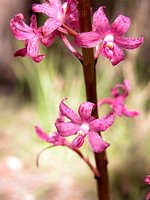 The summer-flowering Ground Orchids have started to flower, as I anticipated last week.
The summer-flowering Ground Orchids have started to flower, as I anticipated last week.The Small Tongue-orchid (Cryptostylis leptochila) has just opened its first flowers. The "tongue" is reflexed upwards and backwards, over the top. The other sepals and petals are reduced to stiff, thin green arms. (Photo courtesy of Anni Heino)
This shape is quite different from the closely related "Cow Orchid" shown last week.
"Pseudo-copulation" is a great word for a bizarre process of pollination used by these Orchids. The flower emits a scent which mimics the pheromone emitted by female insects. In the Cryptostylis genus, male Ichneumonid Wasps are attracted, and seemingly, mistake the flower for a female wasp. They then copulate with the flowers, and in so doing, are dabbed with the pollen of the Orchid. Hopefully they then fly off to another Orchid flower, and complete the pollination cycle for the flower. Shame about the female wasps, though.
This process is not restricted to Australian Orchids, although they have perfected the system. The Cryptostylis genus is famous as the most common example of a plant which has developed "pollination by pseudo-copulation".
 Another beautiful summer-flowering orchid is the tall Hyacinth Orchid (Dipodium roseum) Photo courtesy of Anni Heino) *** (DJW Edit 2 Jan 2010 - Actually Dipodium punctatum - a fact ascertained after double checking most known groups of Hyacinth Orchids shown on this Blog - including where Anni took this photo.
Another beautiful summer-flowering orchid is the tall Hyacinth Orchid (Dipodium roseum) Photo courtesy of Anni Heino) *** (DJW Edit 2 Jan 2010 - Actually Dipodium punctatum - a fact ascertained after double checking most known groups of Hyacinth Orchids shown on this Blog - including where Anni took this photo. It can stand nearly a metre tall, but often less, in poor soil. It has a dark brownish stem, and lovely heads of spotted pink flowers, which, in this species have strongly reflexed petals.
Tricky thing - it has no leaves. It has no chlorophyll, so it cannot make its own food (as most plants do) through the effect of sunlight on the chlorophyll in their leaves and/or stems. It gets its food by forming a relationship with micro-fungi in the soil, which break down old Eucalyptus roots in the ground. Plants which get their food this way are called "saprophytes" - use this link to an article on a related species.
*****
Today I took young George for a flower-spotting walk near his home. In 200 metres we found 24 species of plants in flower. Mostly tiny flowers, but interesting.
George was intrigued by the lovely pink Trigger Plants, (Stylidium graminifolium) which have an elastic organ, shaped like a tiny "hammer". This strikes any insect which touches the sensitive centre of the flower. (They can be "triggered" by the inquisitive amateur botanist, with a fine twig).
For me, the find of the day was a Purplish Beard Orchid (Calochilus robertsonii). This was the first time I have seen this species.
 This photo was taken under difficult, low light conditions (a thick Robertson fog), but it does show the "beard" and the characteristic shallow angle of the "hood" (the dorsal sepal). (Photo courtesy of Anni Heino)
This photo was taken under difficult, low light conditions (a thick Robertson fog), but it does show the "beard" and the characteristic shallow angle of the "hood" (the dorsal sepal). (Photo courtesy of Anni Heino)This plant was growing on shallow black soil, over a sandstone rock shelf. I had seen the similar species: Red Beard Orchid (Calochilus paludosis) growing on poor sandstone soil, several kilometres away.
Have a look at that linked photo to see the differently structured flower, despite the similarities of both being Bearded Orchids.

No comments:
Post a Comment